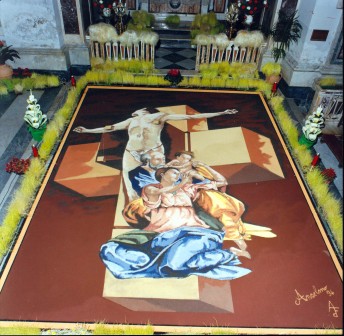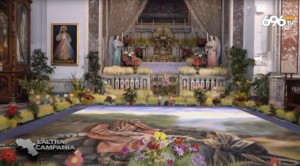
Il tappeto di segatura realizzato a Minori (Costa d’Amalfi) si lega ai riti della Settimana Santa e per tale motivo è detto anche Sepolcro, il luogo dove fu deposto il corpo del Messia dopo la crocifissione;
Il sepolcro, come è ben noto dalla narrazione evangelica, il luogo dove fu deposto il corpo del Messia dopo la crocifissione; il sepolcro nel caso di Minori, adorna l’altare della Reposizione dove è esposto il Santissimo Sacramento per cui non identifica il luogo della morte, ma lo spazio dove il Signore che vi dimora non è una salma ma il Vivente. La lavorazione del tappeto di segatura predilige un sistema che si serve solo ed esclusivamente di segatura setacciata a cui viene unita la polvere tinta. Il termine tappeto è legato alla somiglianza con i tappeti di lana o cotone prodotti nei territori medio-orientali e la cura impiegata per la lavorazione della cornice che racchiude l’immagine, un tempo elaborata con calchi di legno su cui erano praticati degli intagli di forme diverse, rende l’opera di segatura del tutto simile ai drappi di stoffa. Questa illusione ottica è frutto della compattezza che raggiunge la segatura mescolata pazientemente ai pigmenti di colore. In molte zone d’Italia l’usanza di decorare i pavimenti con immagini colorate si lega alla festa del Corpus Domini. A Minori, invece, tale arte viene adoperata esclusivamente per le celebrazioni della settimana santa, manifestando una tendenza diversa rispetto alla tradizione comune. In passato anche altri paesi si fregiavano dell’utilizzo di immagini sacre per decorare gli altari nel periodo pasquale
The sawdust carpet made in Minori (Amalfi Coast) is linked to the rites of Holy Week and for this reason it is also called the Sepulcher, the place where the body of the Messiah was laid after the crucifixion;
The tomb, as is well known from the Gospel narrative, the place where the body of the Messiah was laid after the crucifixion; the sepulcher in the case of Minori adorns the altar of the Reposition where the Blessed Sacrament is exposed so it does not identify the place of death, but the space where the Lord who dwells there is not a corpse but the Living One. The processing of the sawdust carpet prefers a system that uses only and exclusively sieved sawdust to which the dyed powder is combined. The term carpet is linked to the similarity with the wool or cotton carpets produced in the Middle Eastern territories and the care taken for the processing of the frame that encloses the image, once elaborated with wooden casts on which carvings of shapes were made different, makes the sawdust work quite similar to cloth drapes. This optical illusion is the result of the compactness that reaches the sawdust patiently mixed with the color pigments. In many areas of Italy, the custom of decorating floors with colorful images is linked to the feast of Corpus Domini. In Minori, on the other hand, this art is used exclusively for the celebrations of Holy Week, showing a different trend compared to the common tradition. In the past, other countries also boasted the use of sacred images to decorate the altars during the Easter period
